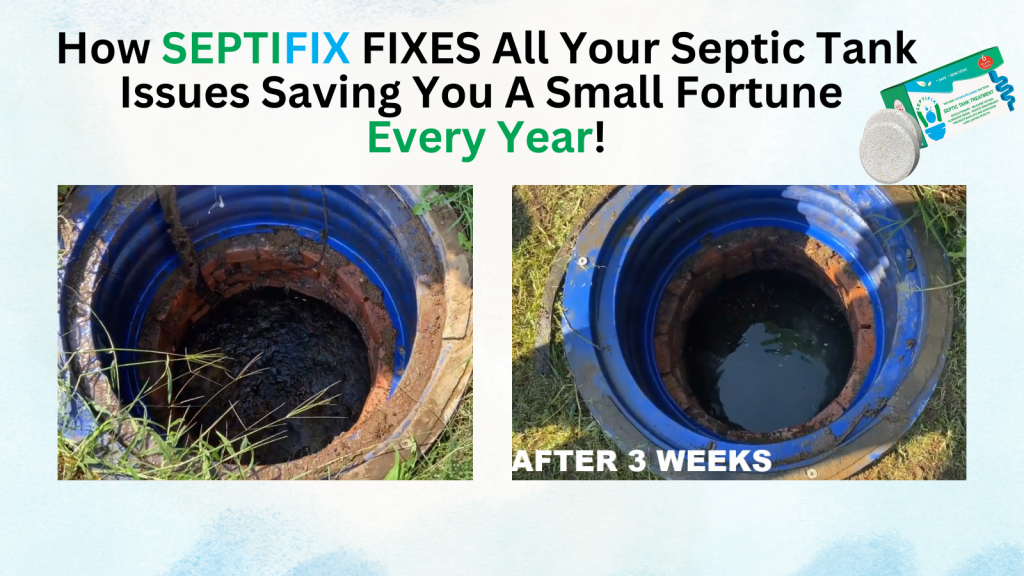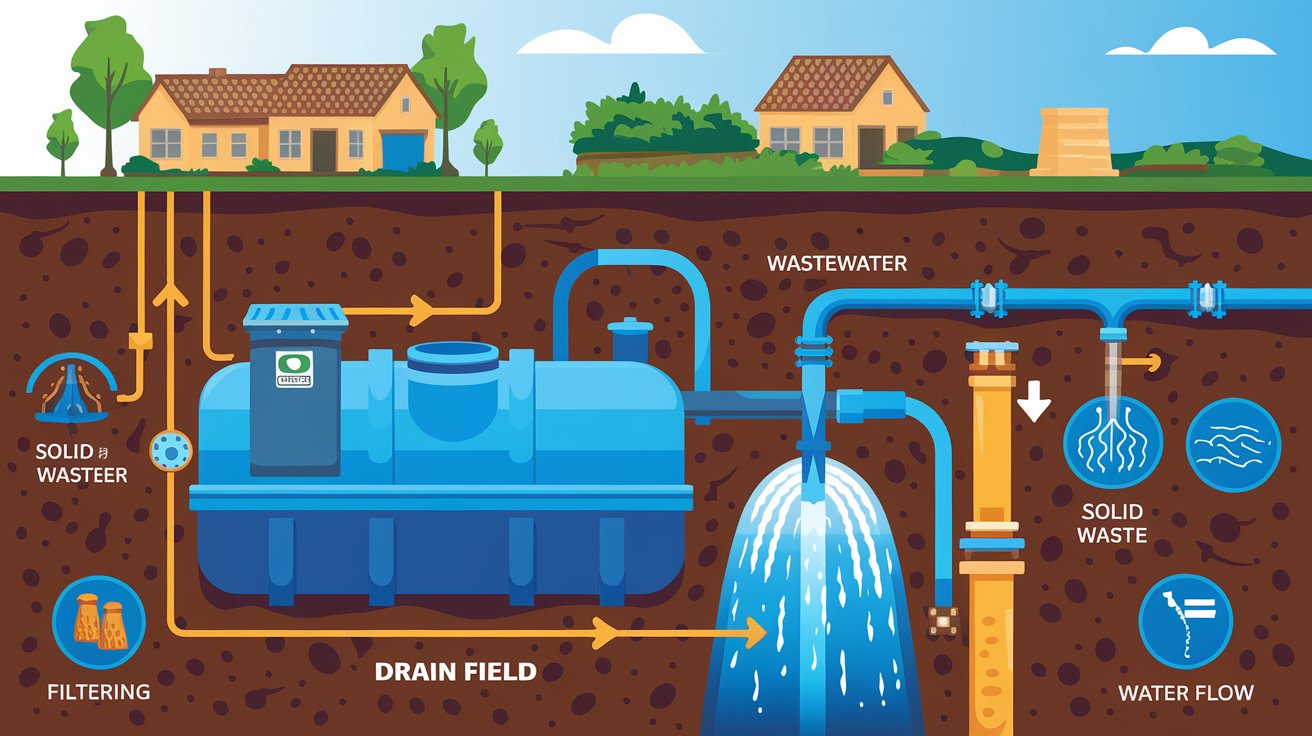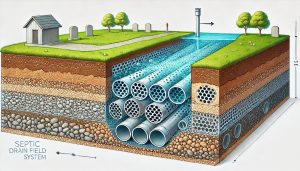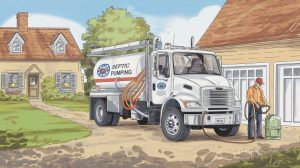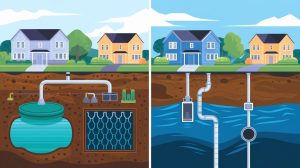If you’re a homeowner with a private wastewater setup, understanding the components of a septic system is essential. These systems play a vital role in managing household waste safely, especially in rural or off-grid areas. Knowing what each part does helps you troubleshoot problems, perform basic maintenance, and make informed decisions when repairs or replacements are needed.
Whether you call it a septic tank, onsite wastewater system, or private sewage system, the fundamentals are the same. Let’s break down the major elements that keep your system running smoothly.
Table of Contents
- Main Components of a Septic System
- Optional but Useful Add-Ons
- How These Components Work Together
- Common Septic System Configurations
- Contact Info and Resources
- Frequently Asked Questions (FAQs) about Septic Systems
- Septifix: Septic Treatment That Works
- Septic Permit Links by State
Main Components of a Septic System
1. Septic Tank
The septic tank is the heart of the system. Typically made of concrete, fiberglass, or polyethylene, it holds wastewater long enough for solids to settle (sludge) and oils to rise (scum).
How It Works:
- Inlet pipe: Receives raw sewage from your home.
- Separation: Solids sink, grease floats, and the remaining liquid (effluent) flows out.
- Bacteria: Anaerobic bacteria break down solids, reducing volume over time.
💡 Pro Tip: Regular pumping (every 3–5 years) is essential to prevent backups.
2. Distribution Box
The distribution box evenly disperses effluent into the drain field. It’s a small concrete or plastic box located downstream of the septic tank.
Key Functions:
- Balances flow to each drain field trench.
- Helps prevent overloading one section of the drain field.
Common issue: If one outlet is lower than others, it may take all the flow and fail prematurely.
3. Drain Field (Leach Field)
Also known as the absorption field, soil treatment area, or leach bed, the drain field is where treated water is filtered naturally through soil.
Structure:
- Perforated pipes in gravel-filled trenches.
- Bacteria in the soil remove remaining contaminants.
⚠️ Warning: Avoid parking, planting trees, or placing heavy items over the drain field to prevent damage.
4. Soil and Subsurface Environment
The unsung hero of any system, soil plays a critical role in final wastewater treatment.
Why Soil Matters:
- Filters out pathogens, nutrients, and organic material.
- Provides aerobic conditions for beneficial microbes.
Not all soil is suitable for septic systems. High clay content or shallow bedrock can reduce absorption efficiency.
5. Plumbing Vents and Inspection Ports
Though less visible, plumbing vents and inspection ports are essential for air exchange and monitoring.
Purpose:
- Vents: Allow gases to escape safely above the roofline.
- Inspection ports: Offer easy access for checking sludge levels or performing diagnostics.
Optional but Useful Add-Ons
Effluent Filter
This filter sits at the septic tank’s outlet and blocks solids from entering the drain field.
- Prevents premature field failure
- Should be cleaned annually
Pump Tank and Pumps (in Some Systems)
For homes where gravity flow isn’t possible, a pump tank lifts effluent to the drain field.
Components:
- Pump tank: Stores effluent temporarily
- Effluent pump: Sends liquid to higher elevation
- Float switches: Control pump activation
💡 Tip: Include an alarm system to alert you of pump failures.
How These Components Work Together
Let’s walk through a real-world example.
Imagine washing dishes in your kitchen sink. That wastewater flows into your septic tank, where solids settle. The remaining liquid moves to the distribution box, which sends it to multiple trenches in the drain field. There, the effluent percolates through gravel and soil, undergoing a final cleaning process before returning safely to the groundwater.
If any one component fails — say, the tank is full or a drain pipe clogs — the entire system can back up or cause environmental damage.
Common Septic System Configurations
Conventional Gravity System
- Most common type
- Uses gravity from the tank to the drain field
Pressure Distribution System
- Uses a pump to evenly distribute effluent
- Ideal for sloped or irregular lots
Mound System
- Built-up drain field with sand fill
- Used when native soil is inadequate
Each system still contains the five basic components described above — only the layout and operation method change.
Contact Info and Resources
Need professional help or planning a DIY septic inspection?
- EPA SepticSmart Program: Educational materials for homeowners
- National Onsite Wastewater Recycling Association (NOWRA): Find certified professionals
- [Your local health department]: They can provide soil test information and permit requirements
- Septic System Treatment Tips: Learn how to protect your system using eco-friendly additives
- DIY Septic Maintenance Guide: Step-by-step help for hands-on homeowners
Conclusion: Know Your System, Protect Your Property
Understanding the components of a septic system gives you the confidence to maintain your setup and catch early signs of trouble. From the tank to the soil, each part plays a role in treating household wastewater safely and sustainably.
Regular maintenance, inspections, and timely pumping are key to avoiding costly repairs and keeping your system — and your property — in top shape.
✅ Call to Action: Take 10 minutes today to locate your septic tank lid, check your maintenance records, or schedule a professional inspection. Small steps now can save you thousands later!
Frequently Asked Questions (FAQs) about Septic Systems
1. How often should I pump my septic tank?
You should have your septic tank pumped every 3 to 5 years, depending on the size of the tank and the number of people in your household. Regular pumping helps prevent the tank from overflowing, which can lead to costly repairs or damage to your drain field. If you notice slow drains or foul odors, it might be time for a pump-out.
2. What can I do to extend the life of my septic system?
To keep your septic system in top shape, follow these tips:
- Schedule regular inspections and pumping.
- Be mindful of what you flush. Only flush toilet paper and human waste—never wipes, hygiene products, or chemicals.
- Limit water usage. Spreading out laundry loads and avoiding excessive water use can help prevent overloading your system.
- Keep the area around the system clear. Don’t plant trees or shrubs near the tank or drain field to avoid root damage.
3. How can I tell if my septic system is failing?
Signs of a failing septic system include:
- Slow drains or frequent backups
- Unpleasant odors around the tank or drain field
- Wet, soggy areas or overly lush grass near the drain field
- Gurgling sounds in your plumbing
- Contaminated nearby water sources (e.g., wells or ponds)
If you notice any of these issues, it’s best to contact a professional right away.
4. Can I use chemicals to maintain my septic system?
It’s not recommended to use harsh chemicals in your septic system. While some products claim to help break down waste, they can also kill the natural bacteria in your tank that are crucial for breaking down solids. Stick to regular pumping and proper maintenance instead of relying on chemicals.
5. What happens if my septic system is clogged or damaged?
If your septic system is clogged or damaged, wastewater may back up into your home, or effluent may not be properly filtered by the drain field. This can lead to unpleasant odors, soggy areas in your yard, and even environmental contamination. It’s important to get any system damage checked out as soon as possible to avoid major repairs or health hazards.
6. Can a septic system be installed in any yard?
Not every yard is suitable for a septic system. The soil needs to be able to absorb and filter wastewater, so a soil percolation test is usually performed before installation. In areas with heavy clay soil or poor drainage, alternative systems like aerobic treatment units (ATUs) or sand filters may be required.
7. How do I know if my septic system has an effluent filter?
Effluent filters are often installed at the outlet of your septic tank. If you’re not sure whether your system has one, check with a professional or have your tank inspected. These filters are a great addition because they prevent solids from reaching the drain field and can help extend the life of your system.
8. What should I do if I smell sewage near my septic system?
A sewage smell around your septic tank or drain field is a clear sign something is wrong. It could indicate that your septic tank is full, your system is backed up, or there is a leak. Avoid using water until you can have the system inspected by a professional to prevent further damage.
9. Is it possible to repair a septic system without replacing it?
In many cases, yes. Small issues like clogged pipes, a malfunctioning distribution box, or a full tank can often be repaired without replacing the entire system. However, if the drain field or septic tank is severely damaged, replacement may be necessary. Regular maintenance can help prevent major repairs and extend the life of your system.
10. Can I build over my septic system or drain field?
No, you should never build over your septic tank, drain field, or any part of your septic system. Doing so can damage the system and make it difficult for waste to be properly processed. It’s important to keep these areas clear of structures, vehicles, or heavy equipment.
Septifix: Septic Treatment That Works
